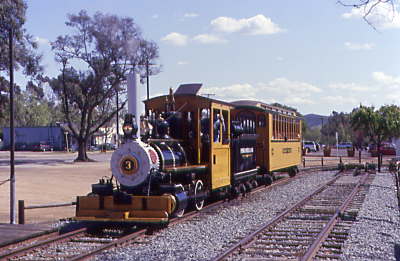
I visited the Descanso, Alpine & Pacific Railway in 1996, but wrote a story about it much more recently. The owner, Roy Athey, asked me if I wanted to come down for another visit. We planned for the third Saturday in March, but a major rainstorm washed away that plan so we rescheduled for April 5th. In the meantime, I checked the Poway Midland Railroad and they were running their steam engine that day. With the Pacific Southwest Railroad Museum in Campo running every weekend, a plan was quickly formed: Alpine first, Campo second and Poway third. Now if the weather would cooperate, it would be a great day of train riding.
A storm was nearing Southern California the night before my trip, but as it turned out, it dropped little to no rain. So that Saturday morning, I left Santa Ana under clear skies and drove towards San Diego but as I neared Sorrento Valley, came to the trailing edge of the passing storm and drove under one very dark cloud and hoped it would not let go. Turning east onto Interstate 8, I passed construction of the San Diego Trolley extension from Mission San Diego to La Mesa. When built, the line will be fun to ride with its bridges, rock ledge-running and tunnel under San Diego State University. I drove to Alpine in a shower but by the time I stopped for petrol and snacks, the shower was over and I drove the short distance to Roy's house.
Descanso, Alpine & PacificRoy Athey, known as "The Train Man" was born in San Diego on August 3, 1931. When he was a young boy, his father ordered a second-hand Lionel train set from the Madison Hardware Company in New York City. It was a passenger train with a locomotive, tender, two coaches and an observation car. It was an 027 set. That means it was "O" gauge and the circle track was 27 inches in diameter.
A few years later, Roy's father bought him a second Lionel train; no locomotive - just four freight cars and a caboose. He also ordered a circle of 072 track. "Oh what a difference it made," said Mr. Athey. "The track was longer and you could go so much faster around the curves."
His love for trains continued and when he was about 15 years old he traded in the Lionel sets for HO gauge scale equipment. After he married and had a son, he started collecting Lionel O gauge trains with his son. When Roy retired in 1988, he decided to build a real railroad on his property in Alpine. He needed a locomotive and found one in Hemstead, Texas and had been used for hauling limestone in a quarry at Carthage, Missouri. It can haul 62 tons.
With the help of his good friend, Casey Derengowski, Roy started laying track and restoring the old locomotive. On February 11, 1992 the old locomotive ran for the first time in many years. Then in June 1993, the trestle at High Pass was completed. They also built a depot, freight shed, engine house, blacksmith shop, section house and three other trestles. The last spike went in on September 22, 2000. Five years later the "Two Foot Gauge Owners Association" indicated that they believed it is the longest operating two foot gauge trestle in the United States.
The railway has three stations, Shade, El Pozo and High Pass and offers free train rides and historical narration to the public on most Sundays.
This two foot gauge railway is typical of many industrial and mining operations and is full-size and not a scale model. The track is constructed of used light rail number 12 to 20, tight curves - 10 foot minimum radius and steep grades of 6.5 percent. The rail came from a number of now abandoned operations: the Warlock Mine in Mojave, California, "a mine in Utah", the Rand Mining District in California, the Poway-Midland Railroad (too light for their use), the Warlock and Blue Mount Mines in Julian, California and Border Field in Imperial Beach.
The rolling stock was made in their shop using an 18" gauge timber car from a mine in Bisbee, Arizona and two-foot gauge brick yard cars from Oklahoma. The locomotive is a 2.5 ton Brookville}, outshopped October 14, 1935 for the Carthage Crushed Limestone Company in Missouri and is powered by a McCormick-Deering P-12, 22.5 horse gasoline engine. This is the same engine that International Harvester Company of Chicago powered their Farmall 12 series tractor with. The locomotive stood idle for 13 years on the two foot gauge Hempstead & Northern Railroad Company in Houston, Texas, before it was obtained and moved to Alpine for restoration on October 14, 1990, its 55th birthday. It was restored to service on February 27, 1992.
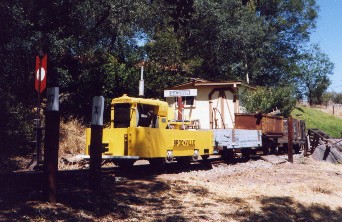
As I drove in, I spotted Roy, who was working on a switch lantern. We went into the Shade Depot out of the chilly air and were reacquainted, with him showing me a photo album of the construction of the line, as well as some very interesting pictures. We walked towards the shop building, stopping off at his newly-built caboose which I toured then Roy showed me his new blacksmithing equipment which was very useful in the caboose's construction.
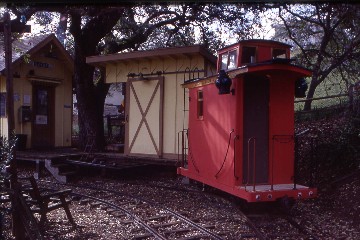
While Roy started the locomotive, I photographed the caboose then met him back at the Shade Depot where I boarded the ore car for another trip and tour of the Descanso, Alpine & Pacific Railway line.
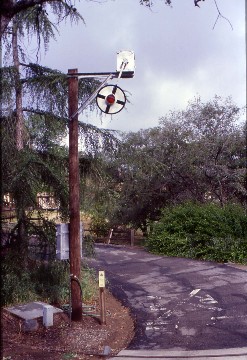
We ran out to the road crossing, where I had driven in, and Roy had a surprise to show me. He had purchased an overhead wig-wag crossing signal which he operated with a garage door opener until he installed the contact points in the track. It did my heart good to see one of these operating again and brought back boyhood memories since when I was growing up in Santa Ana, Southern Pacific had one of these at Washington Street and over at what became Civic Cente Boulevard, was my favorite upper quadrant wig-wag. When the railroad abandoned their line into Santa Ana due to the widening of Interstate 5 for trackage rights on the Santa Fe, both of these wig-wags went the way of the "Great White Buffalo".
We returned along the Tom C. Dyke fill to the Shade Depot by the caboose and over the switch to the lower line then went through the garden by the section house and the locomotive and car shop, climbing the grade towards the loop at High Pass. At the switch we stayed straight.
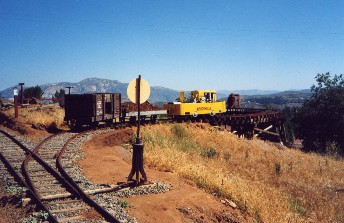
We made our way over the rest of the grade and curved out onto the high trestle at High Pass.
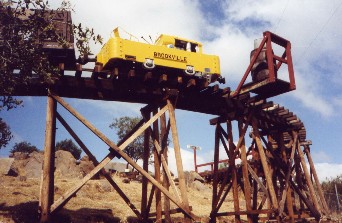
We did not stop to admire the view and made the loop, with Roy jumping off to throw the switch before returning back down to Garden. At the switch there, Roy repeated his switch-tending duties and we were lined for the lower level of tracks. We ran below Tom C. Dyke fill and around a horseshoe curve as we dropped through the overhead trees. At the bottom end of that curve, we turned to the left which took us to the next junction where we stayed straight, but then stopped at New Marnel, where Roy wanted to show me another new acquisition. He now had an 18" gauge train we can run and once he uncovered it, gave me a demonstration of how it works. He next gave me an opportunity to operate it back and forth and I really enjoyed doing that with this unique piece of railroad equipment.
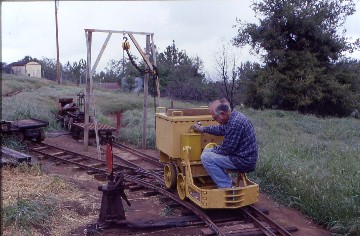
In addition, Roy had a short section of dual gauge track at New Marnel and his plan is to build a line up to a switchback which will end at the No Hope Mine. The engine, called Little Trammer, was manufactured some time prior to 1930 by the Mancha Storage Battery Locomotive Company in St. Louis. The builder's plate indicates "Mine Locomotive Motor, Type M 8, Amps 94, Volts 40, Speed 925, Serial number 20791." The locomotive is powered by two 725 batteries, 20 volts, in series.
We climbed back aboard our train, taking it through the Bobcat Cut, made by a Bobcat tractor, and down to the Howe wooden through-truss trestle, patterned after the one at Hermosa on the Durango and Silverton.
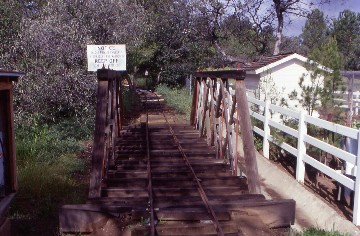
We stopped and Roy told me of the construction it took to create this beautifully-made trestle. We passed El Pozo before we going up to the junction but had to reverse down it in order to go through the switch to return upgrade. Roy will be putting in a wye track here so his trains could just loop around the lower loop in the future. We climbed the grade back up to Garden and with a throw of a switch, returned to the Shade Depot, ending another journey on the Descanso, Alpine & Pacific.
Back inside the Shade Depot, I bought postcards and Roy showed me pictures of the Garrett locomotive was going to be visiting very soon in Texas. After we said our goodbyes, I was off to Campo and it was an easy drive to Buckman Springs Road, although as I drove south into a darkened sky, raindrops started to fall and my windshield wipers were needed. I arrived at Campo with the rain stoppingm but the cold wind really began to blow.
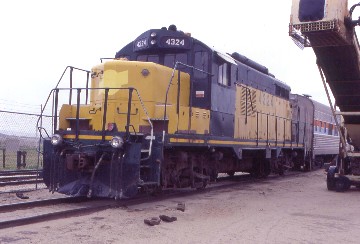

On the road into the museum, I came to the Carrizo Gorge sand unloading facility finding Carrizo Gorge Railroad GP9 4324, ex. Chicago and North Western 4324, nee Chicago and North Western 1716 and Carrizo Gorge Railroad S-4 1465, ex. Relco 1065, exx. Stanley Claster Inc. 1733, exxx. Southern Pacific 1733, nee Texas and New Orleans 45 built by American Locomotive Company in 1947.
Pacific Southwest Railway Museum 11:00 AM Miller Creek TrainIn 1949, two San Diego railfans – educator Frederic "Eric" Sanders and professional musician Douglas I. Duncan – met for the first time by accident while photographing the final operations of the San Diego Electric Railway streetcar system before abandonment. The two men discussed the need for a preservation organization in San Diego and agreed to hold an informal meeting of like-minded fans at Eric's home in La Mesa to continue the discussion. The outgrowth of this first meeting was the formation of the Railway Historical Society of San Diego (RHS of SD). Six years later, the fledgeling group was successful in obtaining a retired steam locomotive and wooden business car from the Southern Pacific Railroad for display somewhere in San Diego. The locomotive was one of the last remaining steam locomotives owned by the San Diego & Arizona Eastern Railway. The former business car had been the private car of John D. Spreckels, builder of SD & AE's predecessor: San Diego & Arizona Railway, between San Diego & El Centro during 1907 – 1919. With the consent of the 22nd District Agricultural Association – operators of the county fair at the Del Mar racetrack – the two historic artifacts were displayed in front of the Bing Crosby exhibit hall and opened to the public during the annual fair.
In 1960, an independent effort, led by a mix of RHS of SD members and others, began a more aggressive parallel effort to explore and establish an operating museum and the following year, formally established the San Diego County Railroad Museum and immediately began the process of incorporation with the Secretary of State. Then in 1963, at the suggestion of Douglas Duncan, the name was changed to Pacific Southwest Railway Museum Association (PSRMA, inspired by the local "Pacific Southwest Airlines", now US Airways).
The Museum's first rolling stock acquisition was former Santa Maria Valley Railroad (Central California) 12-passenger gasoline railbus 9 in 1965 then two steam engines were acquired the next year. Three years later, in 1970, with the consent of the Base Commander, the museum moved its small collection of rolling stock to the mile of private track on Naval Air Station-Miramar. Over time, additional rolling artifacts are added, and a periodic schedule of train operations begun for the benefit of base personnel.
In 1979, the Navy gave notice that the NAS-Miramar spur track was scheduled for removal, and the museum would have to vacate the property as soon as possible. A full-scale search for a new home was launched. An unused five-acre parcel of County land, with an old World War II gymnasium, was discovered in the unincorporated village of Campo, adjacent to the freight-only SD & AE Railway mainline between San Diego & El Centro and 50 miles east of downtown San Diego on State Route 94. The Museum completed the purchase of the Campo property from the County in 1980 and immediately added three plus acres of adjacent private property, for a total of eight acres adjacent to the railroad. Work began immediately to convert the site, about a third of a mile east of the 1917 Campo railway depot – to a functioning railway museum.
All museum rolling stock was moved in 1981 and in 1982, the museum sponsored the first passenger train over the El Cajon Branch of the SD & AE Ry. since 1932, in cooperation with freight train operator, Kyle Railways. During the next three years, great strides were made in the development of the Campo museum site. An agreement was signed with SD & AE owner MTDB to allow the museum to operate vintage passenger trains for the public on the 14 miles of SD & AE Ry. track between the International Border at Division and Milepost 74, eight miles east of Campo.
In 1986, regular weekend museum passenger service began between Campo and Miller Creek, about seven-and-a-half miles miles east. Then in 1987, the museum's first passenger trains from Campo to Tecate, Mexico, using professional freight-train crews occured and PSRMA became the first and only non-profit operating railway museum to operate its trains across an international boundary in the United States.

Arriving an hour and fifteen minutes before train time allowed me to walk through the collection as I am a museum member and saw former California Western 2-6-6-2 46 and one of my favourite engines, Oregon Northwestern AS616 1. I then went to the Box Car Theater and watched a history of the San Diego Arizona and Eastern which kept me out of the cold strong wind. About 10:45 AM, I joined the queue to board the train which consisted of San Diego and Arizona 70 ton switcher 7285, former Erie-Lackawanna coach 250 and former United States Air Force hospital unit, now open window coach 350. Everyone boarded the enclosed coach while I took pictures of our train before boarding the open window car, a very cold place to sit. After we waited for a few latecomers, we finally departed for Miller Creek.
We passed the yard where museum's equipment was displayed and where the restoration takes place then went by Campo Junction and proceeded across Campo Creek to Barrett, where we crossed Highway 94. It was another nice trip, albeit cold, to Miller Creek passing the sign posts of Brown Dog, Sports Curve, Clover Flat, Spencer Crossing and Miller Creek. Along the way, Campo Creek Viaduct was visible to the east and once we arrived at Miller Creek, the locomotive uncoupled and ran around our train. For the return trip, I took shelter in the Lackawanna car and listened to Black Sabbath's "Early Live" and did a few word fill-in puzzles as my body warmed up. Back at Campo Junction, passengers were allowed off for a walking tour of the shops but I stayed on for the final destination of Campo Depot then thanked our conductor for the excellent trip before detraining for my car and my next stop of Poway, or so I thought!
I drove back to Interstate 8 up Buckman Springs Road and had a good drive to El Cajon, where I took California Highway 67 towards Poway. As I was driving up the steep grade, my car suddenly died. My first thought was oh no! Not again, think of what happened in April 2002. I managed to get off the road and turned on my emergency flashers. A man in a pickup truck stopped and let me use his cell phone to call the Auto Club and the representative said my wait would be at least forty-five. As I handed the phone back, this nice man told me to check for a loose wire and he drove off and I opened the bonnet, saw a distributor cable off so I reconnected it and tried to start the engine. Nothing, but if one was off, maybe another one was also. Guess what? Two were off and once I reconnected them, I was good to go. The car started and I was off to solve a new problem, cancelling the tow truck. I drove ten miles to Poway, where I found a pay phone and luckily talked to the same person, who cancelled the call and asked me what the problem had been. When I told her, she said that is the most common problems drivers have in this area, and one the driver can always fix. New lesson learned, always check the wires before calling. I went into the store and received directions to the train in Poway.
Poway Midland RailroadIn Poway, the 1880's presented a prosperous and well-populated valley. Families were settling on farms, planting orchards and vineyards and raising grain. By 1887, there were approximately 800 people in the Poway area. The community during this period had a church, school, hotel, a general store and the expectation of at least two railroad lines coming through the valley. The railroad lines were to pass just west of the present-day Midland Road.
Expectations of the railroad set off a real estate boom and the Piermont Plan for a sub-division came into being. In 1887, developers Baird and Chapin laid out plans to develop a town in the area of today's Old Poway Park, based on these expectations.
The railroad companies, the San Diego Central and the Southern Pacific, proposed a line from Poway to extend toward Ramona and Julian. But the plans failed to materialize due to the railway companies deciding on a lack of sufficient business and the unfeasibility of the valley's terrain. This decision resulted in a real estate bust. Instead, a railway line was built from Escondido to Oceanside in 1887. Railroad plans were brought up again in the late 1890's. At this time Poway's peaches and grapes had become an important crop well recognized throughout Southern California. Fruits were sun dried and sent to the Eastern part of the country. Interest in a railroad was renewed. The people in Poway held a town meeting in the I.O.G.T. Hall and put forth a new proposal which was again negated by railroad officials.
Interestingly enough, the proposed line was to terminate in the area of today’s Poway-Midland Railroad, In the 1960′s, railroad plans were resurrected by Col. John Porter on his property on Midland Road near Aubrey. He laid out a short line for his narrow gauge locomotive and a single car. The pseudo railway was named the Rattlesnake Creek Railroad and extended around his property which encompassed a Poway shopping area. Porter planned to operate it as a commercial entertainment. He died in 1980 without the venture coming to full fruition. The City of Poway acquired the land from the Porter family in late 1986.
A group of volunteers met at the Hamburger Factory in February 1991 and formed the Poway-Midland Railroad Volunteers, their prime purpose being to resurrect a railroad for the people of Poway. In June, the City Council ratified the contract between the City and the Poway-Midland Railroad Volunteers, Inc. to restore, operate and maintain the railroad equipment and all of its facilities.
The Poway-Midland Railroad is a full-size, narrow-gauge railroad in Old Poway Park which carries passengers aboard vintage and antique railroad equipment. The railroad is owned by the City of Poway, and operated by the Poway Midland Railroad Volunteers, is a 501 (c)(3) corporation that exists on passenger ticket fares and donations. Through the restoration, preservation, and operation of vintage railroad equipment, the Volunteers are able to offer the community and visitors alike with a vintage train ride around the park, and through interpretation, provide educational programs (such as Operation Lifesaver) as well.
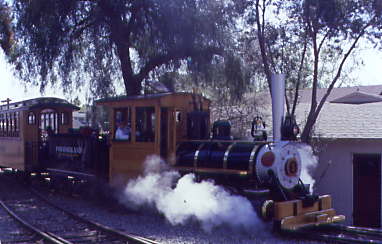
As I entered the parking lot, I saw the steam train and quickly photographed it before it departed, travelling north around their loop and I went across the park for an action shot. The little steamer puffed by and I was off back to the other side of the park for another runby. The train slowed at the depot before starting its second loop around the beautifully laid-out park which the tracks circle. I went to the southwest corner and shot the train crossing Rattlesnake Creek before returning to the depot crossing for another shot. The train stopped and while the passengers detrained, I bought a ticket and postcard before boarding for my first steam train ride here.

Cowell Cement 0-4-0 2 was built in 1907 by the Baldwin Locomotive Works in Philadelphia, Pennsylvania for the Henry Cowell Lime and Cement Company of Cowell, California. The locomotive, originally dubbed "Engine No. 3", and its sister engines were used to haul rock from the company's quarry to the crushing mill, a distance of three miles. In 1952, "Number 3" was sold to the South San Francisco Scrap Metals Company, where it was used to move other pieces of railroad equipment around the scrap yard. In 1960, Charles Pollard of Vista, California, bought "Number 3" and extensively modified its appearance to resemble much older steam engines of the 1870s. He operated the locomotive, then called the "Robert E. Lee" on the grounds of his machine shop. When Pollard died in 1966, the locomotive and various other pieces of rolling stock and railroad equipment were purchased by John S. Porter of Poway. Porter built a small station, house and shed for the train and operated it on his land which today comprises part of our park. Mr. Porter died in 1980, ending the operation of his "Poway Village and Rattlesnake Creek Railroad". In December 1987, the City of Poway purchased the Porter property – lock, stock and locomotive. The locomotive and its tender have been restored to full operational condition by the PMRRV. Restoration, certification and testing were completed early in 1997 and the locomotive made its inaugural PMRR passenger run on July 4, 1997.
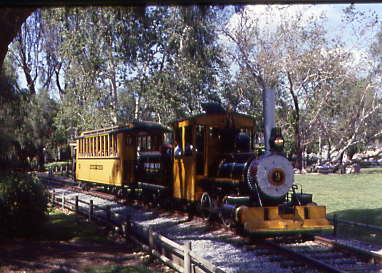
The ride started with a toot of the whistle and we moved slowly by the engine house and I noticed the Southern Pacific caboose and a Santa Fe box car inside the loop. We passed the turntable and crossed Rattlesnake Creek for the first time then ran along the outside of the park with familiess picnicking, having birthday parties or just out enjoying a great day in a great park. We ran in the shade of some large trees along the west side of the park before curving over Rattlesnake Creek and travelling over two grade crossings, each with crossing gates. Inside the loop were shops which were doing a good business. We then curved back to the north and psssed the loading area but continued on a second trip around a very nice railroad. I detrained after a most wonderful trip and met the engine crew, Tom and Steve, who were busy servicing the engine. They invited me up for a cab ride and we talked as we made two more delightful loops around the park.
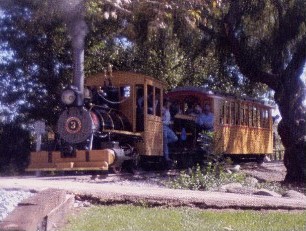
Coming out from underneath the trees.
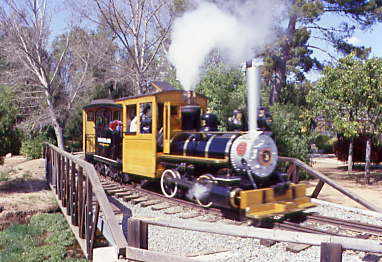
Bursting into the sunlight. I said my goodbyes and drove home to Santa Ana via Interstate 15 to California Highway 78 to Interstate 5, but was home for only two hours before hopping on Pacific Surfliner 784 to Solana Beach and returned on Pacific Surfliner 593, ending another great and very interesting day of train riding.
| RETURN TO THE MAIN PAGE |